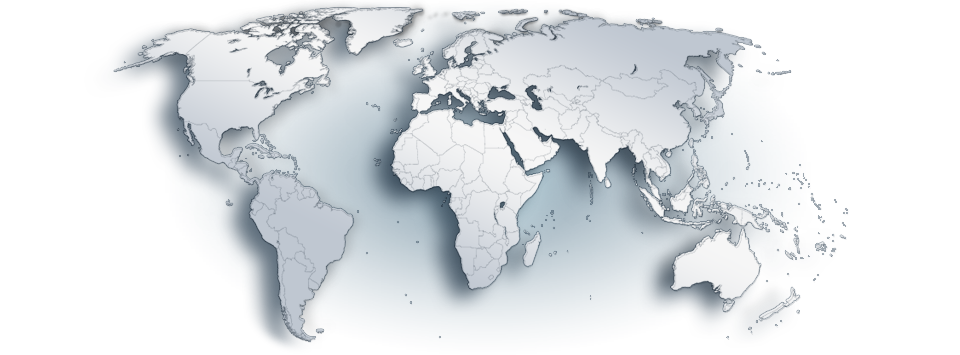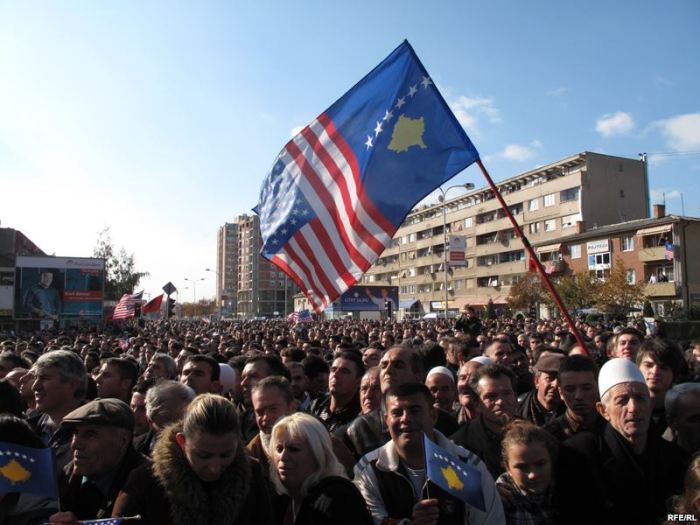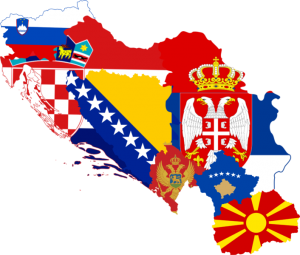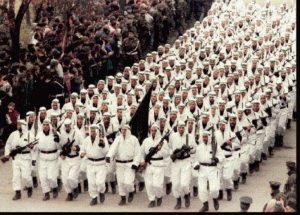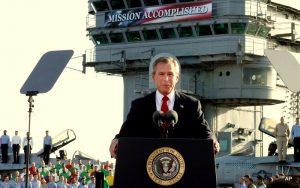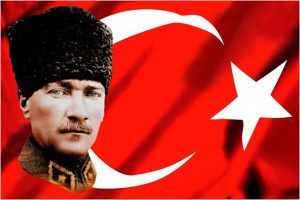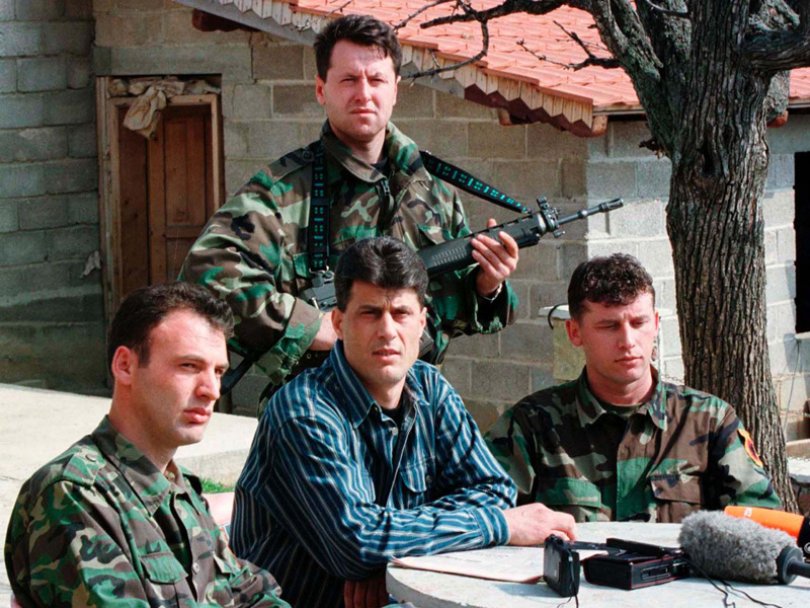
Views: 4102
During the Albanian Muslim secessionist and separatist war in the Serbian province of Kosovo and Metohija, Kosovo Serb civilians were targeted for murder and expulsion. December 14, 2010 marked the 12th year anniversary of the mass murders of six Kosovo Serbs in 1998 by Kosovo Albanian secessionists and separatists. The cold-blooded murder of the six youths was a horrific and shocking mass murder. The killers were Albanian Muslim separatists, suspected members of the KLA, which U.S. special envoy to the Balkans Robert Gelbard described in 1998 as “without any question, a terrorist group”: “I know a terrorist when I see one and these men are terrorists.” These Albanian Muslim “terrorists”, however, would become proxies and allies of the U.S. They would be allowed to abduct, torture, murder, and expel Kosovo Serbs and other non-Albanians. They would also kidnap Kosovo Serbs to harvest their organs. The Pec mass murders in 1998 were horrendous and bestial crimes. Twelve years later, the murderers have not been found.
The Albanian separatist war started with the abductions and mass murders of Yugoslav police and Kosovo Serb civilians. The objective was to provoke a response and to induce U.S. and NATO military intervention against the Yugoslav government. Which they did. The mass murders occurred on Monday, December 14, 1998 in the Kosovo-Metohija city of Pec at the Cafe Panda, at 8.10 PM, when two assailants wearing black masks believed to be KLA separatists fired a Chinese-made automatic weapon from the door at six unarmed Kosovo Serbs, most of them teens. This was a planned and premeditated, cold-blooded mass murder, a slaughter, a massacre, committed by the KLA.
Those killed in the attack were Ivan Radevic, 25, (born in 1972), Ivan Obradovic, 24, (1973), Dragan Trifovic, 17, (1980), and Vukosav Gvozdenovic, 18, (1980). Another two victims, Svetislav Ristic, 17, (1981) and Zoran Stanojevic, 17, (1981), died in the hospital from their wounds. Vladan Loncarevic, 17, (1981) and Mirsad Sabovic, 36, (1962) were seriously wounded. Nikola Rajovic, 18, (1980) was slightly wounded. This was a planned and organized terrorist attack that targeted Kosovo Serb civilians, most of them youths in their teens.
Four of the murdered were in their teens, three were 17, one was 18. The oldest victim was 25, Ivan Radevic, who was the first one killed. His father Bogdan was abducted by the KLA on June 24, 1999, after U.S. and NATO troops occupied the Serbian province, and is presumed dead. His mother Milena was attacked in her house in Pec by the KLA and was forced to flee to save her life. She witnessed the burning of the Serbian section of Pec, Brezenica, as the KLA secessionists burned all the Serbian houses after NATO and U.S. troops occupied the Serbian province.
Milena, the mother of Ivan, recalled the attack in the Panda Cafe in Pec:
“The attackers were masked in black. An innocent conversation of children, young men was stopped and brought to an end forever by a burst of fiery death. The first one to fall was my Ivan, my first-born. He had no possibility to defend himself. The Albanian terrorists have shown that they fight like cowards. A crime against God was committed. Cowards and murderers, blinded by the idea of racism and Nazism, and by a desire for an ethnically clean Kosovo. … They killed our children. I couldn’t accept and I didn’t want to accept that cruel tragedy that my Ivan is now gone. My first-born, my joy. I knew that the moment of misfortune was there beside me. The beast was looking for human flesh and blood. The dogs of war. It was a night when it was not rain that was coming down, but heads and tears. Everybody was losing that night. I lost my Ivan and five more mothers lost their sons. I couldn’t escape the cruel reality. I went dumb-founded from pain. Wounded.
“With a bleeding heart. I didn’t feel any pain when I kept hitting my chests and my head.”
An estimated 10,000 Kosovo Serbs from throughout Kosovo and Metohija attended the funerals for the six youths murdered by the KLA. The funeral ceremony took place on Hero Square on Wednesday, December 16, 1998, in the town center of Pec, the third largest city in the Kosovo province, with Serbian Orthodox Patriarch Pavle and Kosovo Orthodox priests conducting the funeral mass. Flags were at half-mast.
 The bodies of the Kosovo Serbs in the Pec Panda Cafe
The bodies of the Kosovo Serbs in the Pec Panda Cafe
The horrific mass murders did much to galvanize public opinion in Yugoslavia and Serbia against the Albanian separatists and secessionists in Kosovo. This crime was covered by the U.S. and Western media, but it was dismissed and relegated to insignificance. The murderers were “unknown assailants”. Thus, there was no one who was responsible for the murders. It was merely a tragedy. No conclusions or judgments about the Albanian terrorist and separatist war could be drawn from the mass murders. They were random acts of violence. The perpetrators, the mass murderers, were unknown. Move on. Nothing was done by the U.S. or NATO to condemn or sanction its proxies and allies, the KLA. U.S. envoy Richard Holbrooke condemned the KLA mass murders of Kosovo Serbs as “appalling beyond words”, but he was careful to condemn the attack itself, and not the culprits, not the murderers, who were suspected to be KLA gunmen. Who else would have such a genocidal motive? But nothing was done. No actions were taken.
Milena described the funeral for the victims:
“It was for the last time that I was kissing his lifeless and motionless body. I spoke to him, certain that he can hear me and understand.
“Why? Why? Why did I lose you my son, Ivan?
“I was weak. I prayed to God: ‘Don’t give me a burden which is heavier that I can bear.’ You know my heart, my grief, my sorrow…
“Pec was enwrapped in black.”
She took part in the funeral procession to the Pec cemetery:
“As our hearts were breaking apart, on that day at 2 p.m., a long black procession of Pec’s youth and the citizens of Pec and other places in Kosovo and Metohija headed from the Hero Square in Pec towards the town’s cemetery. Ivan was bid the last farewell by his father and me, his brother Djordje and sister Bojana, and his wife Nada, as well as by the family, friends, pals and other citizens of Pec with the prayer: ‘Receive, Lord, the innocent that get killed, their pure arms are lifted towards you, they die for your glory.’ The holy Kosovo soil received them in its warm bosom. The murder of the young men in Pec represented a crime towards a whole nation. The crime went on. Terrorist gangs did not stop with their attacks on the army, police and ordinary citizens.”
She recalled that these crimes culminated in the NATO bombing of Kosovo and Yugoslavia in 1999:
“And then, on 24th March, 1999, NATO aviation started with its aggression on the FRY and kept destroying everything that was on the ground. People, houses, animals, forests, cemeteries. The dead are dying again, they are killed by the dogs of war. And these assist the criminals to keep abducting, killing, torturing, abusing and raping from young girls to old women, everything that is Serbian.”
She compared the mass murder of the teen victims at Pec by Albanian Muslims to the mass murder of Serbian schoolchildren at Kragujevac in 1941 when German troops executed them in retaliation for guerrilla attacks:
“In the close proximity of the Pec Patriarchate and the patriarchate’s mulberry tree which was planted more than 750 years ago by Saint Sava, there was the venue of yet another bloody fairy-tale, the site where another Sumarice took place. They used to spend their youthful days together, with laughter and songs, just as it was on that dreadful night, on Monday, when at their favorite meeting-place, cafe ‘Panda,’ cold steel bullets tore apart their young bodies and disfigured their tender juvenile faces. With a manner of cowards and assassins, blinded and poisoned by the insane idea of racism and Nazism for ethnically clean Kosovo and Metohija, a terrorist Albanian hand killed them perfidiously from the dark.”
The KLA strategy, according to Jane’s Defense, was: “The assassination of Serb officials and civilians from Kosovo’s Serb minority. This included sniper attacks, Serbs dragged from their vehicles and beaten, together with pressure on them to leave their homes.” Albanian Muslim separatists had declared Kosovo independent in 1991 but only Albania recognized them. The separatist conflict that began in 1998 had a two-fold purpose: 1) to engage in murders and terrorist attacks to provoke the Yugoslav government to react to induce U.S. and NATO military intervention against Yugoslavia; and, 2) to kill, intimidate, and expel the Kosovo Serb population to create a de facto ethnically pure Albanian Muslim state.
What was the objective of the KLA separatist? According to the report of the U.S. Committee for Refugees as reported in Reporting War: Journalism in Wartime by Stuart Allan and Barbie Zelizer (Routledge, 2004): “Kosovo Liberation Army … attacks aimed at trying to ‘cleanse’ Kosovo of its ethnic Serb population.” The genocidal policy of the KLA secessionists was obvious and known as early as 1996. Remarkably, the Kosovo Serb victims were ignored in order to manufacture a propaganda construct of Kosovo Albanian Muslims as victims. The UNHCR estimated that 55,000 refugees from Kosovo had fled to Montenegro and Central Serbia during the conflict, most of whom were Kosovo Serbs: “Over 90 mixed villages in Kosovo have now been emptied of Serb inhabitants and other Serbs continue leaving, either to be displaced in other parts of Kosovo or fleeing into central Serbia.”
 The funeral procession for the six murdered Kosovo Serbs in Pec, top. The family of Ivan Radevic, 25, mourns at his funeral, below
The funeral procession for the six murdered Kosovo Serbs in Pec, top. The family of Ivan Radevic, 25, mourns at his funeral, below
At the Hague war crimes tribunal on April 27, 2005, Slobodan Milosevic introduced photographs of the murders and explained their relevance in his questioning of witness Zvonko Gvozdenovic, the father of Vukosav, one of those killed:
“It does have probative value and weight, Mr. Robinson, in order to show the extent of and brutality and savage conduct exhibited by somebody who burst in and killed the children. And if the father sitting here does not object to this being placed on the ELMO, then I don’t see who else should be objecting. Let the witness decide. If the witness says that it should not be placed on the ELMO, I will agree with that decision.”
He asked Zvonko Gvozdenovic:
“Q. Please could you describe what happened on the 14th of December, 1998.
A. On the 14th of December, 1998, a terrible unheard-of crime was committed, unheard of in the 20th century. I must say that even the ETA and IRA, major terrorist organisations in the world, never did any such thing. Where there were children involved, there were no terrorist attacks anywhere in the world, but in Kosovo, in the — on the 14th of December, this was a crime that can only be compared to the Smerica [phoen] [Sumarice, Kragujevac] crime from the Second World War in Kragujevac. These were bandits. No army would do that, not even the KLA as we call them now.
Q. You are now talking about what happened in Pec where your son was killed.
A. Yes. Yes.
…
Q. How many young boys were killed then?A. Six boys were killed then. My son Vukosav Gvozdenovic, my Kum Svetislav Ristic, Ivan Radevic, Dragan Trifunovic, Zoran Stanojevic, and the young boy Ivan Lazovic only 14 and a half years old. I must mention Vlado Loncarevic who was wounded then and who is still suffering severe consequences of that, and Mirsad Sabovic, the owner of the cafe, who was wounded in the foot.
…
Q. After the event, did you go regularly to the graveyard where your son and his friends are buried?A. Yes. Two years later, I went to the graveyard.
Q. You went there two years later. Why did you wait for two years?
A. Well, that’s completely obvious. We even went to see Mr. Gelbard, asking him to enable us to visit this cemetery. He promised us he would. However, for some unknown reasons, Mr. Gelbard never contacted us in order to help us go to the cemetery.
Q. So it was only two years later that you managed to go to the cemetery?
A. Yes.
Q. When did that take place?
A. That was in 2002. And I have to tell you that when we arrived, we found a terrible site.
Q. You mean you went to the cemetery where all of these young men were buried?
A. This is the Orthodox cemetery in Pec.
Q. And what did you find there?
A. We found a terrible sight there at the cemetery. Toppled tombstones, Zoki Stanojevic’s tombstone and Janko Bradovic’s [phoen] tombstones were destroyed. We managed to raise again one tombstone and the other we didn’t manage. The crosses were broken. You can see a cross in one of the pictures. When we went there after the funeral in 2002, there were no crosses or anything there.
Q. All right. You said that this can be seen on the photographs. There is no need to translate that. That’s in tab 6.
A. It seems that everything needs to be translated for them.
Q. What you’re trying to say is that when you arrived two years later, the cemetery was destroyed; the tombstones, the crosses, everything was damaged.
A. Yes, that’s right. I have to tell you that the Italian soldiers who were there as security escorts and who videotaped all of this, they were crying. The Italians videotaped all of this.
Q. And you were forced to go to the cemetery under the protection of Italian security troops.
A. Yes, and they treated us very fairly.
Q. Did anybody give you an explanation for that, how it was possible that something like that happened?
A. Well, we don’t need really an explanation. Nobody guarded the cemetery. When they were able to kill these children, why wouldn’t they be able to destroy the tombstones? Nothing is sacred to them, nothing that is Serbian. You know yourself that in 1981, they set on fire the Pec patriarchate, and that was the first sign.
Q. Mr. Gvozdenovic, based on what you know, after the KFOR arrived, were any other Serbian children killed in Kosovo and Metohija?
A. Yes, that happened in Gorazdevac.
Q. Gorazdevac is a village that you know well?
A. Yes, quite well.
Q. When did that happen in Gorazdevac?
A. I think — I’m not sure any more because there were so many events, that I couldn’t really follow in view of all my problems.
Q. Mr. Gvozdenovic, you were in the village of Bijelo Polje?
A. Yes.
Q. What happened in Bijelo Polje?
A. In that village, when we arrived the first time there, they already started building houses for the Serbs who were supposed to be returning there. I have to tell you that these people are working under very difficult circumstances. However, they are very enthusiastic. What happened was terrible, and that happened on the 17th of March, and everything that they had built was torched, destroyed. And unfortunately, the last time I was there in the cemetery in Pec, on a religious holiday, I saw that these people are exhausted. I really have no words to describe it. The circumstances they live under are so difficult. They’re practically living in a ghetto.
Q. Can Serbs return now to that area?
A. Well, let me give you my opinion. This is my personal opinion, nobody else’s. It would be very difficult for them to return.”
Who was responsible for the murders? A December 17, 1998 communique from the KLA General Staff headquarters blamed the murders on the Serbs themselves, that the Serbs were murdered by Serbs: “we are convinced that the killings were conducted by the Serb secret police.”
 Richard Holbrooke meeting with KLA separatist leader Lum Haxhiu in Junik, Kosovo, June 24, 1998
Richard Holbrooke meeting with KLA separatist leader Lum Haxhiu in Junik, Kosovo, June 24, 1998
Ivica Dacic, the spokesman of Serbia’s ruling Serbian Socialist Party, quoted in Tanjug, stated: “Large guilt in instigating the terrorism [is borne by] … the extreme part of the international community which through its open support to Albanian terrorist gangs in Kosovo and Metohija and their political parties becomes a direct accomplice in the terrorist acts.”
Serbia’s Vice Premier and the leader of the Serbian Radical Party Vojislav Seselj, quoted in Tanjug, “accused today the USA and ‘their allies’ of guilt and responsibility for the crime that took place in Pec. In the press conference, Seselj said the crime wouldn’t have happened if NATO hadn’t appeared as the direct protector of the terrorists.”
The Yugoslav daily Borba, as reported by the AP, “in a sharply
worded commentary, called on the international verifiers and US envoys to leave Kosovo, calling them ‘direct instigators and helpers of the crimes committed by Albanian terrorists.’ ”
The AP reported that “a crowd of 5,000 assembled in the western city of Pec” for the funeral held on Wednesday, December 16, 1998, quoting the principal of the high school the victims attended as saying that the Kosovo Serb youths were ” ‘killed for the simple reason of being Serbs.’ He concluded with a demand that the state ‘punish the perpetrators and do away with Albanian terrorism forever.’ ”
The AP quoted a top government body for Kosovo which called the killings “the most monstrous crime in the series of assaults by Albanian terrorist gangs.”
 The Pec mass murders occurred in the context of the KLA terrorist and secessionist war in Kosovo. U.S. Special Envoy Richard Holbrooke and Milosevic had negotiated a cease-fire signed on October 16, 1998. The KLA violated this cease-fire, however, by smuggling troops and weapons into Kosovo from bases in northern Albania. Roland Keith, a field office director of the OSCE Kosovo Verification Mission, noted the egregious and blatant KLA violations of the agreement: “The situation was clearly that KLA provocations, as personally witnessed in ambushes of security patrols which inflicted fatal and other casualties, were clear violations of the previous October’s agreement [and United Nations Security Council Resolution 1199].” Reporters and KLA troops themselves had revealed that U.S. and NATO were training and supplying the KLA secessionists at bases in Albania as early as 1996, two years before the outbreak of the conflict in Kosovo.
The Pec mass murders occurred in the context of the KLA terrorist and secessionist war in Kosovo. U.S. Special Envoy Richard Holbrooke and Milosevic had negotiated a cease-fire signed on October 16, 1998. The KLA violated this cease-fire, however, by smuggling troops and weapons into Kosovo from bases in northern Albania. Roland Keith, a field office director of the OSCE Kosovo Verification Mission, noted the egregious and blatant KLA violations of the agreement: “The situation was clearly that KLA provocations, as personally witnessed in ambushes of security patrols which inflicted fatal and other casualties, were clear violations of the previous October’s agreement [and United Nations Security Council Resolution 1199].” Reporters and KLA troops themselves had revealed that U.S. and NATO were training and supplying the KLA secessionists at bases in Albania as early as 1996, two years before the outbreak of the conflict in Kosovo.
The Pec mass murders were seen as retaliation and as a reprisal for the deaths of 36 KLA separatists who were killed in a gunfight with Yugoslav forces while attempting to come into Kosovo from supply and military bases in Albania. This was the putative motive for the mass murders in Pec. Reuters reported that on Monday, December 14, 1998, “Yugoslav troops killed 36 ethnic Albanian guerrillas near the Albanian border as they tried to cross into Kosovo with guns and supplies.” The Serbian Media Center reported that on December 14, 1998, the Albanian secessionists were killed in “clashes with the Yugoslav Army border guards, while trying to illegally cross from Albania to Yugoslavia early this morning between 2 to 7 AM, the Prizren municipal authorities confirmed to the Media Center.
“The Yugoslav Army border guards captured large quantities of modern weapons and military equipment, the armed Albanians tried to smuggle in to Yugoslavia. The killed and wounded, the same source claimed, wore masked uniforms with the insignia of the separatist ‘Kosovo Liberation Army.’ ”
Reuters on Tuesday cited a member of the Kosovo Verification Mission:
“A total of 140 KLA members were coming over the border into Kosovo carrying weapons and equipment… They encountered a [Yugoslav army] sentry post and one was killed instantly, so then they turned back to return to Albania… But after they turned around, they were ambushed and 25 were shot and killed and were taken prisoner, including one woman… Our initial feelings are that this was a normal military operation… and not a set-up.”
The Washington Post described the corpses of the KLA separatists who had been killed in order to concoct some sort of Yugoslav atrocity or massacre of terrorists, a precursor of the Racak “massacre’ modus operandi: “Western officials who saw the bodies, or saw close-up photographs, said yesterday that many of the victims had been shot in the head or the face. To some officials, that suggested the victims were killed deliberately and at close range, and not in a battle; to others it bore the earmarks of a well-organized ambush by highly-trained Yugoslav Army sharpshooters. The latter view, a senior official said, is shared by most of the Western military experts who have studied the event. But the matter is not likely to be verified until the Yugoslav Army provides the Western experts access to seven group members who were captured near the site of the killings. ‘The prisoners are the key to everything,’ the official said. But Yugoslavia has not indicated it would provide such access.”
The Daily Telegraph of London noted that “the ambush is evidence that the KLA is continuing to build up its strength. It is also proof of the efficiency of the Serb troops sealing the border.” The violations of the Holbrooke-Milosevic cease-fire agreement showed that the KLA separatists were determined to continue the terrorist war in Kosovo until they induced the U.S. and NATO to intervene on their side.
And who was behind the KLA terrorism and mass murders in Kosovo? Sen. Joe Lieberman was quoted in The Washington Post, April 28, 1999: “[The] United States of America and the Kosovo Liberation Army stand for the same human values and principles … Fighting for the KLA is fighting for human rights and American values.” The KLA separatists and terrorists were always proxies and allies of the U.S.
The KLA began its terrorist war in 1996 with the bombing of refugee camps housing Serbian refugees from the wars in Bosnia and Croatia, expelled during the U.S.-organized campaign that ethnically cleansed over 250,000 Krajina Serbs. There were reports that the CIA and the German Bundesnachrichtendienst (BND) were training and supplying the KLA as early as 1996 in bases in Albania. When the KLA was changed from a terrorist organization to proxies and allies of the U.S. and NATO, British SAS teams, US Special Forces, and representatives from Military Professional Resources Inc. (MPRI) were actively and openly training KLA fighters at bases in Albania as reported in the Daily Telegraph, April 18, 1999 and the Herald (Glasgow), March 27, 2001. The U.S. and Germany recruited Arab-Afghan mujahedeen mercenaries, financed by Saudi Arabia and Kuwait, to train the KLA in guerrilla tactics. The Sunday Times reported that Fatos Klosi, the head of the Albanian intelligence service, as saying a network run by Saudi Arabian mujahedeen leader Ossama Bin Laden sent units to fight in the Serbian province of Kosovo. Bin Laden was reported to have visited Albania in 1994.
U.S. Special Envoy Richard Holbrooke met with two KLA separatist leaders on June 24, 1998 in the Kosovo town of Junik. AP writer Adam Brown noted that the controversial meeting resulted in “tacit recognition of the Kosovo Liberation Army’s growing strength.” Holbrooke’s solution was for the Yugoslav forces to “withdraw” to let the KLA separatists take over the territory and reinforce their positions with more troops and weapons smuggled in from bases in Albania. And this is exactly what happened after the cease-fire Holbrooke negotiated. Holbrooke only exacerbated the conflict.
What happened to the Kosovo Serb residents after U.S. and NATO troops occupied Kosovo? Milena Radevic recalled the events when her husband Bogdan was abducted by the KLA separatists:
“On 24th June, 1999, at 8 o’clock, two Albanians in civilian clothes, armed with pistols, came to the gate of our house. They wanted Bogdan to go out for some talk. I was overcome by fear. I couldn’t hear what they were saying and after ten minutes Bogdan came back in. I could see by his face that something was wrong. For the first time I felt fear in his speech. ‘We cannot stay in the house any longer,’ he said. They requested him to go for a permit to their headquarters or else we may not stay in the house, not even for 24 hours. They said that we would have to move out unless we obtain the permit or else they would kill us. ‘For, this is Albania ,’ they said. The NATO soldiers, that we had asked for help, didn’t want to protect us. Bogdan set off to go to the Albanian headquarters. We parted in silence and with our glances, feeling that we would never see each other again. He left without looking back. I followed him with my glance, with premonition and fear. Then he turned and I could see that he was crying. We’ve never seen each other again since then. All trace of him is gone since then. Later I found out, when I became a refugee, from the telling of witness Dragan Sekulovic from Pec, who moved in his car from Belo Polje near Pec, with four more passengers, that he saw Bogdan. ‘Luckily for us, but unfortunately for Bogdan, an armed and uniformed KLA group stopped Bogdan who was heading towards the centre of the town, they asked for his ID and then started to beat him,’ Dragan told me. Since that moment, all trace of Bogdan is lost.”
These are crimes without punishment. The murderers of the six unarmed victims in Pec were never apprehended. No one is searching for the Albanian mass murderers. They murdered both the son, Ivan, and the father, Bogdan, and expelled the mother Milena from Kosovo, destroying the Radevic family. No one was held responsible or accountable for the horrific crimes committed in Pec.
Originally published on 2010-12-16
Author: Carl K. Savich
Source: Serbianna
Origins of images: Facebook, Twitter, Wikimedia, Wikipedia, Flickr, Google, Imageinjection & Pinterest.
Read our Disclaimer/Legal Statement!
Donate to Support Us
We would like to ask you to consider a small donation to help our team keep working. We accept no advertising and rely only on you, our readers, to keep us digging the truth on history, global politics and international relations.
